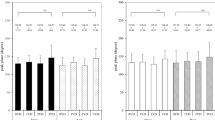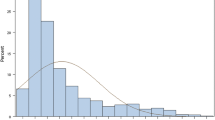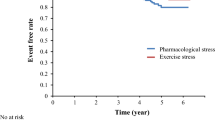Abstract
Background
There is increasing awareness of the value of phase analysis of gated tomographic myocardial perfusion imaging in assessing left ventricular (LV) dyssynchrony. A concern repeatedly raised in many studies is whether reversible defects in the stress images “ischemia” could affect the phase-derived standard deviation and bandwidth, the two commonly used dyssynchrony indices. We hypothesized that the stress and rest images should provide comparable information because the images are acquired 1 hour after the tracer injection.
Methods and Results
We studied two groups of patients with normal LV ejection fraction and no fixed perfusion defects. In group-1 (N = 20), the patients had reversible perfusion defects involving > 10% of the LV myocardium and in group-2 (N = 20), the patients had normal images. All patients underwent stress/rest-gated single photon emission computed tomography sestamibi imaging (the stress study was acquired with the lower dose) between January and March 2010. Patients with left bundle branch block or ventricular pacing were excluded. The patients in group-1 had a mean age of 61 ± 9 years, 65% were men, 75% Caucasians, and 70% had known prior coronary artery disease. The size of the reversible perfusion defect was 20 ± 13% (range 11%-50%) of the LV myocardium. The rest and stress phase-derived standard deviation (16 ± 6° vs 18 ± 8° and 16 ± 7° vs. 19 ± 6°) and the rest and stress bandwidth (42 ± 14° vs 46 ± 16° and 45 ± 17° vs 52 ± 12°), respectively, (P = NS for all) were similar in the two groups. The change (stress–rest) in standard deviation and bandwidth in groups 1 and 2 were not statistically significant (0.2 ± 3.1° vs 1.4 ± 4.7°, and 2 ± 13° vs 5 ± 13°, respectively, P = NS). There was no significant change from rest to stress in the standard deviation and the bandwidth in group-1 (P = .8 and .4, respectively) and group-2 (P = .2 and .08, respectively). There was no correlation between the size of the reversible perfusion defect and the change in phase standard deviation or bandwidth (r = 0.07 and 0.12, respectively, P = NS).
Conclusions
The presence of even a large reversible perfusion defect does not alter the indices of mechanical dyssynchrony by phase analysis. Further, comparable information is obtained whether using a low dose or a high dose of the radiotracer.



Similar content being viewed by others
References
Chen J, Garcia EV, Folks RD, Cooke CD, Faber TL, Tauxe EL, et al. Onset of left ventricular mechanical contraction as determined by phase analysis of ECG-gated myocardial perfusion SPECT imaging: Development of a diagnostic tool for assessment of cardiac mechanical dyssynchrony. J Nucl Cardiol 2005;12:687-95.
Trimble MA, Borges-Neto S, Smallheiser S, Chen J, Honeycutt EF, Shaw LK, et al. Evaluation of left ventricular mechanical dyssynchrony as determined by phase analysis of ECG-gated SPECT myocardial perfusion imaging in patients with left ventricular dysfunction and conduction disturbances. J Nucl Cardiol 2007;14:298-307.
Trimble MA, Borges-Neto S, Honeycutt EF, Shaw LK, Pagnanelli R, Chen J, et al. Evaluation of mechanical dyssynchrony and myocardial perfusion using phase analysis of gated SPECT imaging in patients with left ventricular dysfunction. J Nucl Cardiol 2008;15:663-70.
Aljaroudi WA, Hage FG, Hermann D, Doppalapudi H, Venkataraman R, Heo J, et al. Relation of left-ventricular dyssynchrony by phase analysis of gated SPECT images and cardiovascular events in patients with implantable cardiac defibrillators. J Nucl Cardiol 2010;17:398-404.
Hansen CL, Goldstein RA, Akinboboye OO, Berman DS, Botvinick EH, Churchwell KB, et al. Myocardial perfusion and function: Single photon emission computed tomography. J Nucl Cardiol 2007;14:e39-60.
Germano G, Kiat H, Kavanagh PB, Moriel M, Mazzanti M, Su HT, et al. Automatic quantification of ejection fraction from gated myocardial perfusion SPECT. J Nucl Med 1995;36:2138-47.
Ficaro EP, Lee BC, Kritzman JN, Corbett JR. Corridor4DM: The Michigan method for quantitative nuclear cardiology. J Nucl Cardiol 2007;14:455-65.
Iskandrian AE, Garcia EV, Faber T, Mahmarian JJ. Automated assessment of serial SPECT myocardial perfusion images. J Nucl Cardiol 2009;16:6-9.
Berman DS, Kang X, Gransar H, Gerlach J, Friedman JD, Hayes SW, et al. Quantitative assessment of myocardial perfusion abnormality on SPECT myocardial perfusion imaging is more reproducible than expert visual analysis. J Nucl Cardiol 2009;16:45-53.
Chen J, Faber TL, Cooke CD, Garcia EV. Temporal resolution of multiharmonic phase analysis of ECG-gated myocardial perfusion SPECT studies. J Nucl Cardiol 2008;15:383-91.
Iskandrian AE. Stress-only myocardial perfusion imaging a new paradigm. J Am Coll Cardiol 2010;55:231-3.
Atchley AE, Trimble MA, Samad Z, Shaw LK, Pagnanelli R, Chen J, et al. Use of phase analysis of gated SPECT perfusion imaging to quantify dyssynchrony in patients with mild-to-moderate left ventricular dysfunction. J Nucl Cardiol 2009;16:888-94.
Achilli A, Sassara M, Ficili S, Pontillo D, Achilli P, Alessi C, et al. Long-term effectiveness of cardiac resynchronization therapy in patients with refractory heart failure and “narrow” QRS. J Am Coll Cardiol 2003;42:2117-24.
Yu CM, Lin H, Zhang Q, Sanderson JE. High prevalence of left ventricular systolic and diastolic asynchrony in patients with congestive heart failure and normal QRS duration. Heart 2003;89:54-60.
Boogers MJ, Schalij MJ, Bax JJ. Should mechanical dyssynchrony be assessed in patients with implantable cardioverter-defibrillators? J Nucl Cardiol 2010;17:354-8.
Henneman MM, Chen J, Dibbets-Schneider P, Stokkel MP, Bleeker GB, Ypenburg C, et al. Can LV dyssynchrony as assessed with phase analysis on gated myocardial perfusion SPECT predict response to CRT? J Nucl Med 2007;48:1104-11.
AlJaroudi W, Aggarwal H, Venkataraman R, Heo J, Iskandrian AE, Hage FG. Impact of left ventricular dyssynchrony by phase analysis on cardiovascular outcomes in patients with end-stage renal disease. J Nucl Cardiol 2010. doi:10.1007/s12350-010-9271-x.
Iskandrian AE, Garcia EV (eds). Nuclear cardiac imaging: Principles and applications. In: Zoghbi GJ, Iskandrian AE, editors. Pharmacological stress testing. 4th ed. New York: Oxford University Press; 2008. p. 293-315.
Kass DA. An epidemic of dyssynchrony: But what does it mean? J Am Coll Cardiol 2008;51:12-7.
Conflicts of interest
None.
Author information
Authors and Affiliations
Corresponding author
Rights and permissions
About this article
Cite this article
AlJaroudi, W., Koneru, J., Heo, J. et al. Impact of ischemia on left ventricular dyssynchrony by phase analysis of gated single photon emission computed tomography myocardial perfusion imaging. J. Nucl. Cardiol. 18, 36–42 (2011). https://doi.org/10.1007/s12350-010-9296-1
Received:
Accepted:
Published:
Issue Date:
DOI: https://doi.org/10.1007/s12350-010-9296-1




